|
THURSDAY EDITION April 18th, 2024 |
|
Home :: Archives :: Contact |
 |
The Time of SandsJeff Rubin and Peter Buchanan from Occasional Report #56, CIBC World Markets
February 10th, 2006
Despite a doubling in crude prices over the last two years, non-OPEC supply failed to grow in 2005, resulting in a modest million barrel net increase in daily global production. Energy markets should brace themselves for another year of tight supply, as the rebound in production growth once again falls short of expectations. Over 60% of the 3.6 million barrels of new oil production that will come on stream in 2006 will not support demand growth but simply offset the loss from depletion of existing fields such as the North Sea or the giant Burgan field in Kuwait. Net of depletion, conventional oil supply will continue to decline this year, just as it did last year. 2004, in hindsight, will prove to be a Hubbert curve peak, at least insofar as low-cost conventional crude is concerned. In any event, all of the increase in net global crude supply this year, as well as for the rest of the decade, will come from non-conventional sources like deep-water and oil sands. We live not only in a world of rapidly depleting conventional oil supplies, but also in a world in which those that remain are increasingly beyond the private sector’s reach. Virtually all of OPEC’s massive production remains in the hands of staterun oil companies. What little is in private hands is being quickly converted back under state control as recent events in Venezuela attest. And even outside of OPEC, the picture isn’t much different. From Mexico to Russia, which has embarked on a de facto re-nationalization of its industry, the bias towards state control over energy resources remains strong. About 80% of the world’s conventional oil reserves remain effectively off limits to private investment. The combination of depleting reserves and sweeping state ownership has left each of the world’s six largest publicly traded oil firms looking at probable production declines over the next two years. That sets the stage for a mad scramble for whatever proven reserves the market still has access to. And there are no greater reserves accessible to private investment than the Canadian oil sands. Deep-water wells may be the primary source of non-conventional production now, but by the end of the decade, slated production increases will make oil sands the single biggest contributor to incremental global supply. Planned capacity expansions in Canada’s oil sands even exceed planned increases in Saudi Arabia over the next decade. As oil prices continue to rise to over $70 per barrel this year and to as much as $100 per barrel by the end of 2007, more and more of the world’s oil firms will seek a foothold in these huge, but costly reserves. If the 2-year decline in conventional production holds, this once marginal energy source may not only become one of the world’s most valuable, but one of the few remaining still open to investors. Limited Response to Past Price Hikes The failure of the 50% increase in crude prices over the last year to cool demand has seen West Texas Intermediate jump back over US$60/bbl and slowly inch its way back towards the US$70/bbl peak hit last summer. While the rise has seen oil companies ramp up their exploration and development budgets, the supply picture for at least the rest of the decade is already in place, painted by lead times of five years or more between discovery and production. The 164 pending oil field and oil sands projects already at some stage of their development pretty well defines the upper limit of global production over the balance of the decade. Our analysis of the supply pipeline suggests that not only will net supply increases to the global market be extremely limited over the next several years, but that on a net basis, all of the new supply will come from non-conventional sources such as deep-water and Canadian oil sands—a development that can only buttress fears of growing depletion of conventional resources. That concern is now being echoed by some of the world’s largest oil companies, firms that have historically scoffed at the very notion of depleting oil supplies. Today they are increasingly speaking of an unprecedented gap between supply and demand growth. For example, ExxonMobil has recently concluded that more than half of the hydrocarbon supplies needed over the next 15 years has yet to be developed (Chart 1). Discovery is only one element of the supply equation. Crude markets are poised to become even tighter in the future due to declining productivity in some of the world’s most prolific oil fields, as they pass their prime producing years. Failure to account for depletion from existing fields is a common error repeatedly made by supply optimists who focus only on gross additions to production. Not only is depletion significant, but it is also accelerating, forcing more and more reliance on non-conventional sources of supply such as Canada’s vast but largely undeveloped oil sands. While that resource has proven reserves that rival those of Saudi Arabia, they can only be
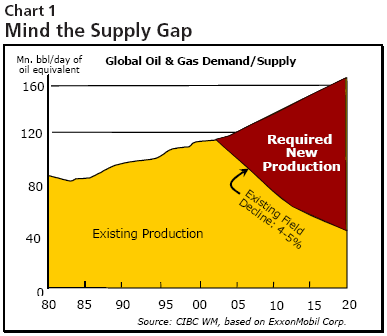 extracted at three to four times the cost of conventional oil. Costlier, Non-Conventional Crude Dominates Capacity Growth According to the International Energy Agency, the world produced about 84 million barrels of oil per day in 2005. Sixty or so major new oil capacity projects are slated to come on line in the next two years according to our tabulations, compared to just over forty in 2005. Among the most noteworthy in the coming year are Phase 1 of the UAE’s Upper Zakum project, rated at over 600 thousand barrels daily, and ACG Phase 2 in the ex- Soviet bloc (see Table 2, page 6). On a global basis, new field developments will add about 3.6 million barrels of oil production capacity in 2006, 3.7 million in 2007 and some 3.1 million barrels of capacity in 2008. That captures both the first flow of oil from newly minted fields (such as the Gulf of Mexico’s Thunder Horse) and the ramping up to capacity in fields that have started producing in the last two years such as Nigeria’s Bonga field and the Sakhalin project. Much more costly non-conventional oil will account for 60% of the increase in global production over the next three years. The amount from just one component of this alone—deep-water oil—exceeds projected new conventional crude capacity (Chart 2).
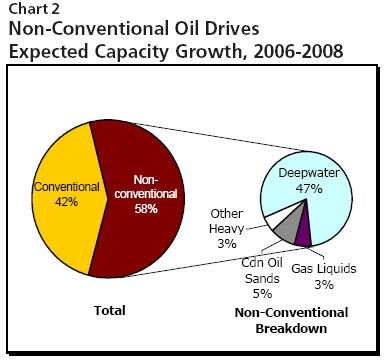 Deep-Water Oil a Bridge to an Oil SandsFuture Added deep-water production in the Gulf of Mexico represents virtually all of planned new field capacity in the US through decade’s end. As the past fall’s one-two storm punch from hurricanes Katrina and Rita clearly showed, that lack of diversification entails appreciable risks. We think as much as half of the planned 750,000 barrels per day of new Gulf of Mexico capacity over the next three years could be delayed, as the industry grapples with recovery from extensive hurricane damage to fields and industry infrastructure in the Gulf region. And if this year’s weather patterns are repeated in the Gulf of Mexico over the balance of the decade, it is debatable whether deep-water production in the Gulf can even be sustained at today’s level, let alone increased significantly as planned. The growing shortage of offshore rigs poses another constraint on the pace of deepwater development, particularly in fields off Brazil and the west coast of Africa. Each account for about a third of the increase in global deep-water capacity over the next three years. The offshore
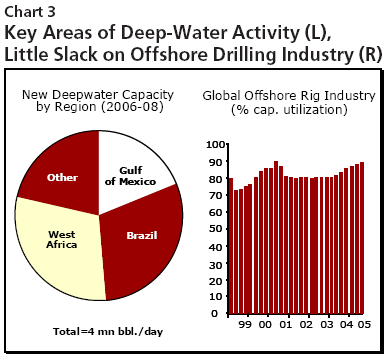 drilling industry is already operating at near-record capacity on a global basis (Chart 3). Production from the oil sands will ramp up at a slower pace than deep-water wells, due to even larger capital spending requirements and other constraints, but should replace deep sea and conventional oil as the key factor driving production capacity growth by decade’s end. With 30 new oil sands developments on tap (see Table 1 on page 5), representing close to 3 million added barrels of daily production, Alberta has more new capacity on the drawing boards than even oil super-heavyweight Saudi Arabia (Chart 4). Announced new oil sands projects will lift estimated daily Canadian oil and gas liquids production to 3.5 million bbl by 2008 and 4 million barrels by 2010, solidifying Canada’s role as a key player in energy markets (Chart 5). Depletion: The Elephant in the Room Depletion, the other key determinant of effective supply, along with new field development, has received added attention with the news that Kuwait’s giant Burgan field, the second largest in the world, has started to run dry. Rising depletion
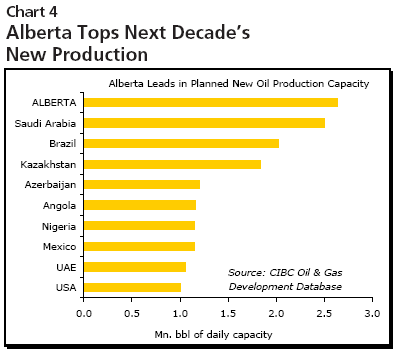 levels mean in effect that oil firms these days must run faster just to stand still. Facing the loss of more than 2 million barrels per day of production every year, some two-thirds of projected capacity growth over the next three years will go not towards expanding consumption, but will simply replace falling output at tired, aging fields like Mexico’s Cantarell complex, the North Sea and now Burgan (Chart 6).
 Depletion rates vary—depending on geology, production history and other factors—being higher as a rule for offshore than onshore formations. In our work, we’ve assumed an average rate of 1.6% for the Middle Eastern countries and that the varying levels for the rest of the world average out to 3.4% (Chart 7). Those figures are consistent with estimates of depletion from such experts as the noted petroleum geologist Colin Campbell.
 Subtracting depletion of around 2.2 million barrels annually from our estimates of new field production capacity leaves about 4½ million barrels of daily production available to support consumption growth through decade's end. As noted previously, all of the net increase in global production will come from non-conventional sources such as deep-water and oil sands production (Chart 8). Assuming that consumption continues to increase at a near-2.5% trend rate, spurred by rapidly rising energy demand in countries like China and India, oil consumption will soon exceed projected global supply growth, requiring further price rationing to bring demand growth back in to line with the very modest supply growth we see lying ahead.
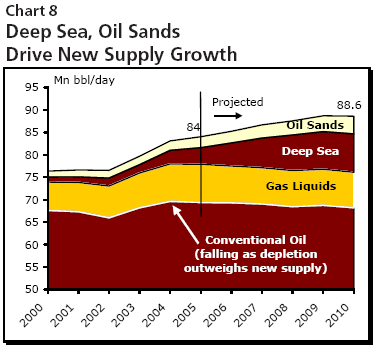
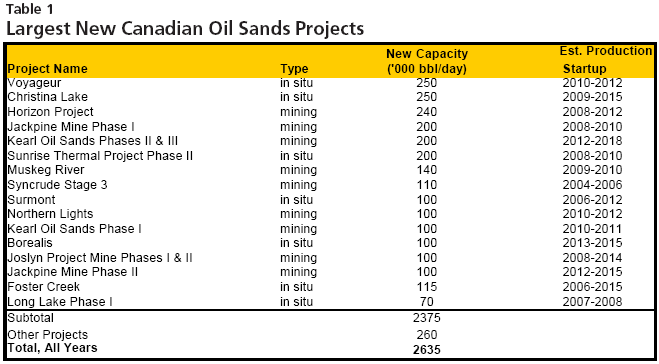
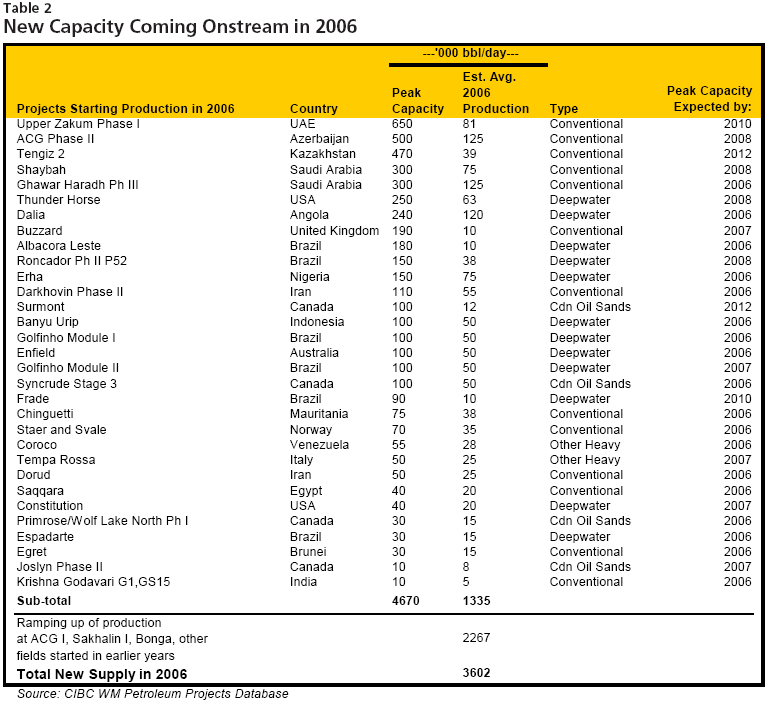 by Jeff Rubin and Peter Buchanan from Occasional Report #56, CIBC World Markets
February 10, 2006
Conflicts of Interest: CIBC World Markets’ analysts and economists are compensated from revenues generated by various CIBC World
Markets businesses, including CIBC World Markets’ Investment Banking Department. CIBC World Markets may have a long or short position
or deal as principal in the securities discussed herein, related securities or in options, futures or other derivative instruments based thereon.
The reader should not rely solely on this report in evaluating whether or not to buy or sell the securities of the subject company.
Legal Matters: This report is issued and approved for distribution by (i) in Canada by CIBC World Markets Inc., a member of the IDA and CIPF,
(ii) in the UK, CIBC World Markets plc, which is regulated by the FSA, and (iii) in Australia, CIBC World Markets Australia Limited, a member
of the Australian Stock Exchange and regulated by the ASIC (collectively, “CIBC World Markets”). This report has not been reviewed or
approved by CIBC World Markets Corp., a member of the NYSE and SIPC, and is intended for distribution in the United States only to Major
Institutional Investors (as such term is defined in SEC Rule 15a-6 and Section 15 of the Securities Act of 1934, as amended). This document
and any information contained herein are not intended for the use of private investors in the UK. The comments and views expressed in
this document are meant for the general interests of clients of CIBC World Markets Australia Limited. This report is provided for informational
purposes only. This report does not take into account the investment objectives, financial situation or specific needs of any particular client
of CIBC World Markets Inc. Before making an investment decision on the basis of any information contained in this report, the recipient should
consider whether such information is appropriate given the recipient’s particular investment needs, objectives and financial circumstances.
CIBC World Markets Inc. suggests that, prior to acting on any information contained herein, you contact one of our client advisers in your
jurisdiction to discuss your particular circumstances. Since the levels and bases of taxation can change, any reference in this report to the
impact of taxation should not be construed as offering tax advice; as with any transaction having potential tax implications, clients should
consult with their own tax advisors. Past performance is not a guarantee of future results. The information and any statistical data contained
herein were obtained from sources that we believe to be reliable, but we do not represent that they are accurate or complete, and they
should not be relied upon as such. All estimates and opinions expressed herein constitute judgements as of the date of this report and are
subject to change without notice. Although each company issuing this report is a wholly owned subsidiary of Canadian Imperial Bank of
Commerce (“CIBC”), each is solely responsible for its contractual obligations and commitments, and any securities products offered or
recommended to or purchased or sold in any client accounts (i) will not be insured by the Federal Deposit Insurance Corporation (“FDIC”),
the Canada Deposit Insurance Corporation or other similar deposit insurance, (ii) will not be deposits or other obligations of CIBC, (iii) will not
be endorsed or guaranteed by CIBC, and (iv) will be subject to investment risks, including possible loss of the principal invested. The CIBC
trademark is used under license.
© 2005 CIBC World Markets Inc. All rights reserved. Unauthorized use, distribution, duplication or disclosure without the prior written
permission of CIBC World Markets Inc. is prohibited by law and may result in prosecution.
|
| Home :: Archives :: Contact |
THURSDAY EDITION April 18th, 2024 © 2024 321energy.com |
|